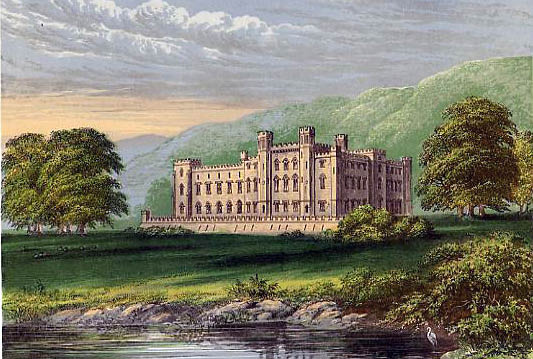
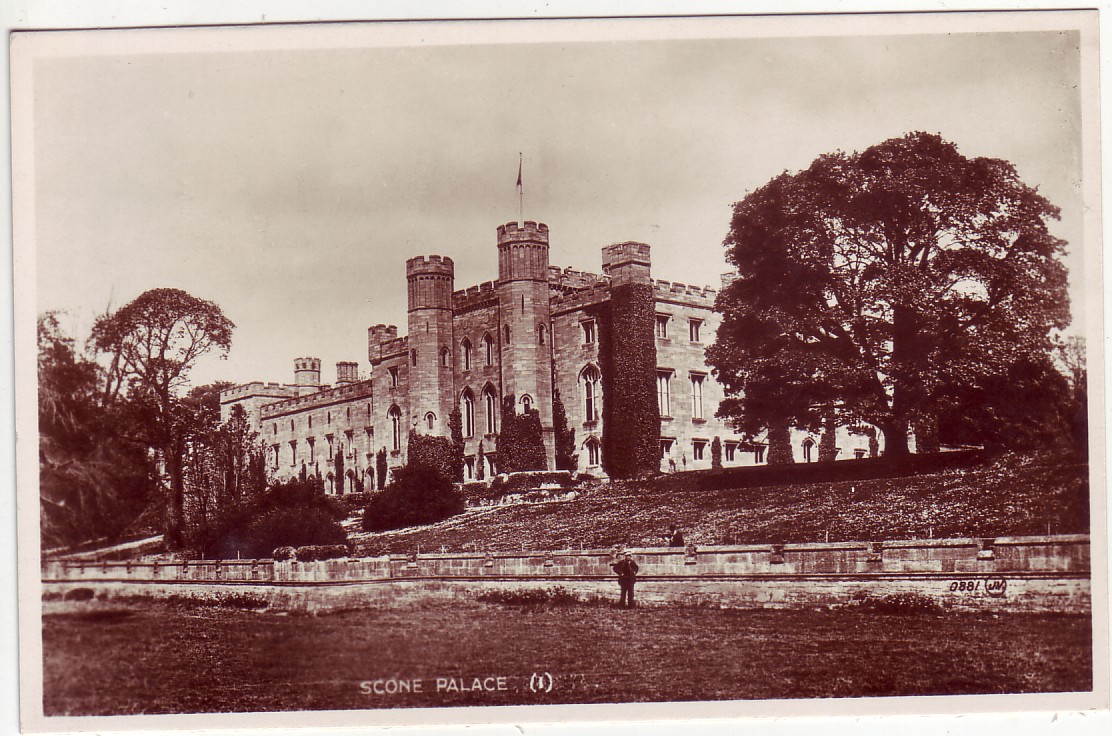
Above, Scone Palace, near Perth.
John Murray Wighton taking a stroll around the grounds of his ancestral home?
| John Baxter and Catherine Latta's Gift to their Son |
 |
 |
| Above, Scone Palace, near Perth. |
John Murray Wighton taking a stroll around the grounds of his ancestral home? |
|
The royal palace at Scone (pronounced Skoon) was the closest thing that the Kingdom of Scotland had in its earliest years to a capital. In the 1100's, for example, Scone Abbey was the principal seat of the kingdom and the place where Scottish kings were crowned. A medieval village grew up around the monastery and royal residence. However, Scone did not lie on a navigable part of the River Tay, and so it was one mile away at Perth that a larger village became established. Scottish kings continued to be crowned at Scone until the end of the Scottish kingdom and the unification with England in 1707. Although Scone retained its role in royal inaugurations, its role as effective capital declined in the later Middle Ages and most of the old village had disappeared by 1600. The palace was given to David Murray, newly created Lord Scone, who in 1621 was promoted to Viscount Stormont. The palace evidently remained in a decent state, as the Stormont Murrays did some rebuilding and continued to reside there, and it continued to play host to important guests, such as to King Charles II when he was crowned there in 1651. The medieval village of Scone was abandoned in the early 19th century when the residents were removed and a new palace was built on the site by the third Earl of Mansfield, as the Murray family was now named. The new palace was reconstructed from the ancient building and incorporated parts of the original structure. |
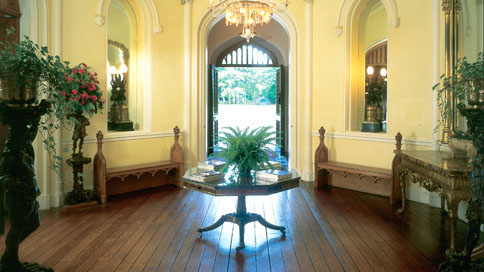 |
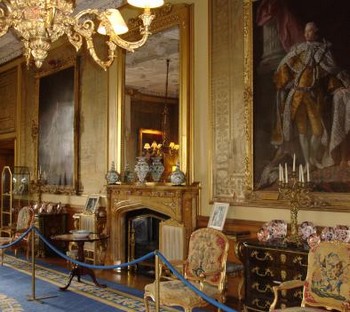 |
| Above, the Octagonal Room in Scone Palace. |
John Murray Wighton's bedroom circa 1880? |
|
So, who were these Murrays/Mansfields anyway? And, what does this have to do with the Wighton family who was descended from a Scottish crofter living in poverty in Meigle, Perthshire? In the mid-twelfth century, the Pictish Province of Moray (the area surrounding Inverness) was under the rebellious influence of King MacBeth's descendants. The incumbent, King David I, sent a Flemish knight to banish the rebels. This Knight was Ollec Freskin who was granted lands and extensive authority over Moray. Freskin's family intermarried with Moray's ancient royal family, thereby gaining hereditary rights to the land. In time, they took the name of the area which subsequently was spelled as Murray. Now, many centuries later, Murray is the most common territorial name in Scotland and is the 12th most frequent surname in Scotland. One of Freskin's grandsons was Hugo de Moravia who became the First Lord of Sutherland and was the progenitor of the Clan Sutherland. The clan's traditional territory was in the northern highlands, south of Orkney and Caithness. Hugo's brother William was progenitor of the Clan Murray. From him descend the principal houses of Murray (including the Stormont/Mansfield Murrays), Tullibardine, Atholl, Abercairney and Polmaise. Through advantageous marriages, the clan inherited lands in eastern Perthshire, for example the Duke of Atholl, the head of the clan, had estates covering 300,000 acres and was given the right by Queen Victoria to have his own private army (the Atholl Highlanders). (dw: Personal note: the kilt that I wear from time to time is in the tartan of the Duke of Atholl.) The Murray name is one of the most famous of Scotland's aristocratic families. Within the direct line of the Stormont/Mansfield Murrays, for example, one can find reference to a Lord Chief Justice, a solicitor general, an attorney general, and a first lord of the Admiralty. Murrays in this family have also been British ambassadors, MPs, high ranking army officers, and knights. We're run across the Murray family before in our genealogical meanderings. Patrick Murray, 5th Baron Elibank bequeathed the ownership of the land and buildings at Potento (Meigle) and Simprim to an illegitimate son Patrick Murray in the late 1700s. The Elibank Murrays and the Stormont Murrays share a common ancestor. So... why am I telling you about the Palace at Scone and the Murray family? The answer is simple. The Wighton family is related to the Murray family, and to reveal that relationship subtly, John Baxter and Catherine Latta christened their son, John Murray Wighton. |
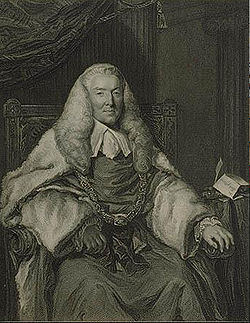 |
| Above, William Murray, First Earl of Mansfield, 1705-1793 |
|
"OK, you got me interested," you admit. "How are the Wightons related to one of the most aristocratic Scottish families in history?" The answer comes to us indirectly from Amy Louisa Hutcheon, the wife of John Murray Wighton. ALW must have told her sister, Margaret (Hutcheon) Herald the story, because she in turn wrote about it in a letter to John Latta Wighton and Ella Peterson (generation 8). According to Margaret Herald, John Murray Wighton's great-grandmother was of the family of Earl of Mansfield, Perthshire. Murray was the family name. The picture above shows the Earl of Mansfield during the time that JMW's great-grandmother became part of the Murray family. There are two ways that JMW's great-grandmother could be of the family of the Earl of Mansfield. There's the romantic possibility...> A young Murray lass is stuck in Meigle one day while her father is in a business meeting. She was trying to do her math homework and was pondering a difficult question that involved a coach travelling from Perth to Dundee and another coach travelling from Dundee to Perth but at a different speed. She was supposed to determine how long it would be before the coaches met but she couldn't make heads nor tails of it and so asked a young peasant sitting nearby to help her. He showed her how to figure it out, and in showing her how to use the slide rule he had just invented, their hands accidentally touched and they fell in love, she gave up her wealth, etc. You're right. It probably didn't happen that way. That leaves the other alternative which involves a Murray male and a young Scottish lass involved in something not quite as romantic. We have some confirmation that this is what happened since Margaret Serzan's grandmother (Amy Louisa Hutcheon's daughter) told Margaret that the Wighton's were related to a Duke, but it was on the wrong side of the blanket. That leads us to the question of Who? and When? John Murray Wighton would have had four great-grandmothers, two from the Latta side of the family and two from the Wighton side. Since we don't know anything about Catherine Latta's family, and since they lived in western Scotland a long way from the Mansfield Murrays, we can probably rule them out. That leaves the Wighton side of the family. JMW's paternal great-grandmother was John Baxter Wighton's paternal grandmother, who was John (shoemaker) Wighton's mother - - - namely Elizabeth Taylor. She was christened January 10, 1762 in Meigle. If Elizabeth Taylor was really of the Murray family, that meant that it was Elizabeth Taylor's mother who would have been involved with the Murray gentleman. Elizabeth Taylor's mother was Jannett Whitten, born in Meigle in 1735. Jannett Whitten married John Taylor in Meigle in 1760, two years before Elizabeth Taylor's birth. Elizabeth was the first of nine children, all born in Meigle. While Perth is 20 long miles from Meigle, a branch of the Murray family (Lord Elibank) did own land where Jannett Whitten was living and perhaps a Mansfield Murray was visiting at the time. Or, perhaps a Mansfield Murray owned property nearby. JMW's second great-grandmother was John Baxter Wighton's maternal grandmother, who was Ann Baxter's mother, --- namely Janet Adam who was born in 1772 in Alyth. If Janet Adam was really "of the Murray family", that meant that it was Janet's mother who would have been involved with the Murray gentleman. Unfortunately, we only know the name of Janet's father - Peter Adam, a miller. Peter's wife had nine children between 1757 and 1772, Janet being the last. This theory is more difficult to believe. If Janet's mother were the woman involved with the Murray gentleman, she would have been relatively old at the time (Janet was her ninth child). That, and living in a mill several miles into the countryside near Alyth makes it hard to imagine how she would have been romantically involved with a Murray gentleman. (Incidentally, the mention of Peter Adam's occupation as a miller reminded me that I had some information on how popular millers were in the 1700s. Here's an essay you can read if you're interested in learning more about Why the Miller Didn't Get Citizen of the Year Awards during the 18th century.) This leaves Elizabeth Taylor as the most likely candidate for carrying Murray genes into the family. But, as hard as it is to imagine how and when this might have happened, we don't really need to identify the people involved and/or prove the theory. What we do know is that John Murray Wighton, was a frequent visitor to Scone Palace on the invitation of William David Murray, Viscount Stormont. Viscount Stormont even invited JMW to his daughter's wedding. You'll learn more about this in JMW's biography - but doesn't it seem unusual to you that a lowly civil servant would be given these invitations if that's all he was to them? When John Murray Wighton was born, Scotland's class system was still highly favourable to the aristocracy. While a middle class was slowly emerging, Scottish society was still rigidly stratified. The owners of the new mills and factories were slowly emerging as candidates for the upper classes through their wealth. But, a good life for the average Scot was still a dream. Even in the military, where John Baxter Wighton achieved great success, his prospects were capped. Promotion from the ranks to officer status was not possible; in fact, commissions in the army had to be purchased and were reserved only for those families who had the wealth to buy their son a future. It would have been common knowledge that success in Scottish life was gained only if you were born wealthy. But, it would have been common knowledge, as well, that the indiscretions of the nobility were often quietly taken care of. So, in 1857, John Baxter and his wife must have decided that they would attempt to have the family's connection to the Murray family recognized in some fashion favourable to their son. The Murray name opened doors, so why shouldn't their son also benefit? Of course, this wasn't something that earlier Wighton fathers could ever have considered. What would they do? Would a stone mason walk to Perth, knock on the palace's front door, and say, "Please tell the Earl that I'm related to him." The aristocracy was so far removed from their lives that making contact with them in any fashion was inconceivable. But, John Baxter Wighton had been working in the company of the aristocracy for most of his military life. From 1853 when he was promoted to Colour Sargeant of his regiment, he would have interacted personally and on a regular basis with aristocrats - the officers of the regiment. Staff sargeants were named as such since they were on the regimental staff, as led by the General of the regiment, himself a leading aristocrat. Clearly, JBW was good at managing that contact because they kept on promoting him until he had climbed as high as he could. Then, after retirement from active army duty, he continued to work with the nobility by serving as a factor for their estates. John Baxter Wighton had the contacts, and the skills, to dare to approach the Mansfields and ask for a favour for his son. Did he do this? We don't know. We do know that Viscount Stormont served in the Crimea War with the Grenadier Guards and was present at the siege of Sebastopol, just as JBW was. Also, in 1871, when JBW was on the regimental staff of the 5th Brigade Scottish Divisional Artillery, Lord Stormont was Colonel of the Perthshire Militia. Might JBW have had contact at either of these times? Did John Murray Wighton benefit from his middle name? You'll have to read the rest of his biography and make up your own mind. Sources Various web sites, including: Clan Family Histories: http://www.rampantscotland.com/clans/blclanmurray.htm Murray Family History: http://www.carothers-carruthers.com/murray Clan Murray: http://en.wikipedia.org/wiki/Clan_Murray |